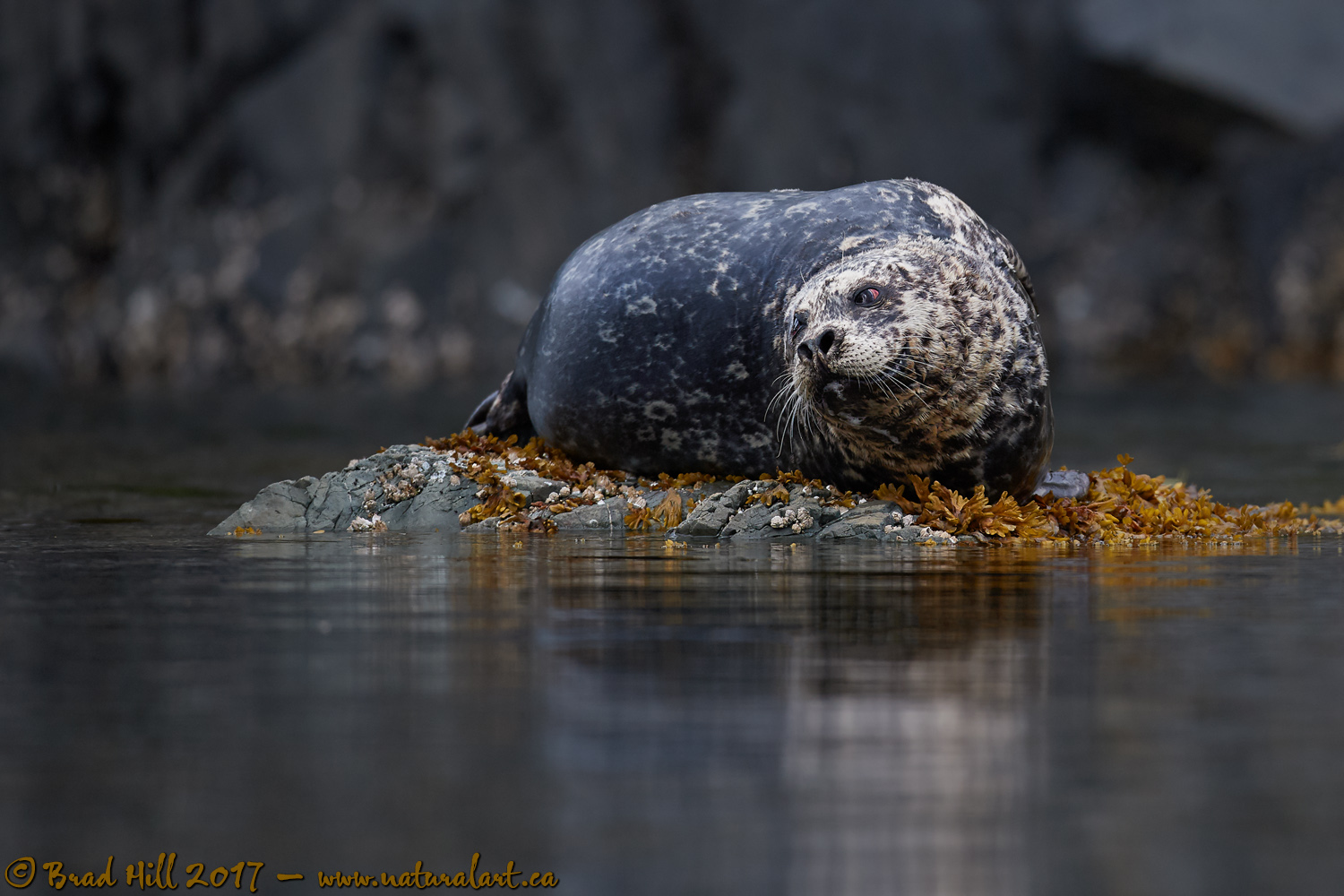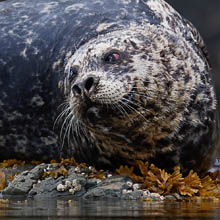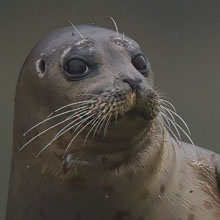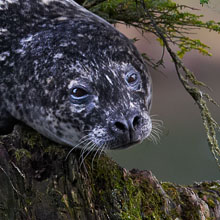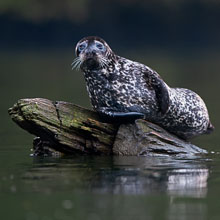Availability: Undetermined - Enquiries?
In the Field
Simply a Seal. Northern Vancouver Island Region, BC Canada. August 18, 2017.
So...just a seal, eh? Well to some I suppose that's true. But I know of at least one photographer (yours truly) that just LOVES to photograph seals. In fact, one of my "dream images" (that currently exists ONLY in the bucket list in my head) is a certain very special image of a seal. One of these days all the conditions needed to take that shot out of my mind's eye and convert it to pixels will come together! Until then I'll keep myself occupied searching for that shot...and picking up some other interesting shots along the way.
I have a bit of a hard time explaining what intrigues me so much about seals. Some of it is undoubtedly related to their amazing faces (everything there from their great whiskers through to their massive and doleful eyes). And maybe part of it is related their aquatic lifestyle and environs (that seems such an odd environment...or at least so "different"...for fellow mammals to inhabit).
When I saw this scene setting up I was pretty excited. I knew that shooting with a large aperture on my trusty Sigma 500mm f4 lens would provide a very clean and simple shot. And...the natural colour contrast (much of it supplied by the orange-brown fucus growing on the rock "perch") appealed to me. And...while others may find it distracting...I liked the hint of red in the eye (to me these kind of accents are great "make ‘em to look twice" elements and add to the shot).
So...simply a seal, eh? ;-)
Here's a larger (2400 pixel) version of this almost cuddly pinniped:
• Simply a Seal: Download 2400 pixel image (JPEG: 1.0 MB)
ADDITIONAL NOTES:
1. This image was captured during my "Humpback, Sea Lions & More" Marine Mammals photo tour in the summer of 2017. Each year I offer trips into two different parts of the Great Bear Rainforest as well as one to photograph marine mammals and oceanscapes near the northern tip of Vancouver Island. And, in selected years, I also offer photo tours to locations to capture other highly sought-after subjects, such as various boreal owl species and wildlife of Canada's Arctic. Details about these trips can be found on the Photo Tours page of this website.
2. This image - in all resolutions - is protected by copyright. I'm fine with personal uses of them (including use as desktop backgrounds or screensavers on your own computer), but unauthorized commercial use of the image is prohibited by law. Thanks in advance for respecting my copyright!
3. Like all wildlife photographs on this website, this image was captured following the strict ethical guidelines described in The Wildlife FIRST! Principles of Photographer Conduct. I encourage all wildlife photographers to always put the welfare of their subjects above the value of their photographs.
Behind the Camera
Simply a Seal. Northern Vancouver Island Region, BC Canada. August 18, 2017.
Digital Capture; Compressed RAW (NEF) 14-bit format; ISO 800.
Nikon D5 paired with Sigma 500mm f4 Sport lens. Hand-held from floating Zodiac. OS on and in "OS1" mode, with OS1 stabilization customized to Moderate View mode; AF customized to Fast Priority AF.
1/2500s @ f4.5; -1.0 stop compensation from "recommended" matrix-metered exposure setting.
At the Computer
Simply a Seal. Northern Vancouver Island Region, BC Canada. August 18, 2017.
RAW Conversion to 16-bit TIFF using Phase One's Capture One Pro 10. Four raw variants (different versions of a single raw capture) processed, with the variants differing in exposure settings (0.5 stop total difference between the variants) and both highlight suppression and shadow recovery settings.
Further digital corrections on resulting 16-bit TIFF files using Adobe's Photoshop CC 2017 and Light Crafts Lightzone. Photoshop adjustments included compositing (blending) of the four output files from the raw converter, very minor exposure tweaks, and final selective sharpening for web output. Final tone-tweaking performed using LightZone's "tonemapper" tool.
Conservation
Simply a Seal. Northern Vancouver Island Region, BC Canada. August 18, 2017.
Ten percent of the revenue generated by this image will be donated to The Raincoast Conservation Foundation.
Species Status in Canada*: Most Harbour Seal populations in Canada are not listed as Threatened or Endangered. The Lac des Loups Marins landlocked population of Quebec (Ungave Peninsula) currently listed as Endangered (most recent assessment update - November 2007).
The Harbour Seal (Phoca vitulina) is found on both the eastern and western coasts of North America. They tend not to make long migrations and in many areas they are present year-round. When foraging Harbour Seals normally dive to between 30 and 100 metres in depth and stay below the surface for 5 to 6 minutes. On occasion they have been known to dive to depths of over 450 metres and have stay submerged for almost 30 minutes. Harbour Seals have a diverse diet, including cephalopod, crustacceans and a variety of fish such as herring, eulachon, pollock, and salmon.
Historically bounty programs were used in both Canada and the USA to reduce populations of Harbour Seals. In more recent times seals have become protected over much of North America and some populations have rebounded strongly (it is estimated that over 150,000 seals now occupy the coast of British Columbia). There is a land-locked and freshwater sub-species of the Harbour Seal found on the Ungava Peninsula of northern Quebec. This population is now down to an estimated 100 individuals and is listed as Endangered by COSEWIC.
The Raincoast Conservation Society (and Foundation) is an effective and efficient organization that has been fighting for protection of this unique habitat. If you are looking for a meaningful way to contribute to the conservation of this amazing ecosystem, Raincoast will provide maximal "bang" for your conservation dollars.
*as determined by COSEWIC: The Committee on the Status of Endangered Wildlife in Canada.












